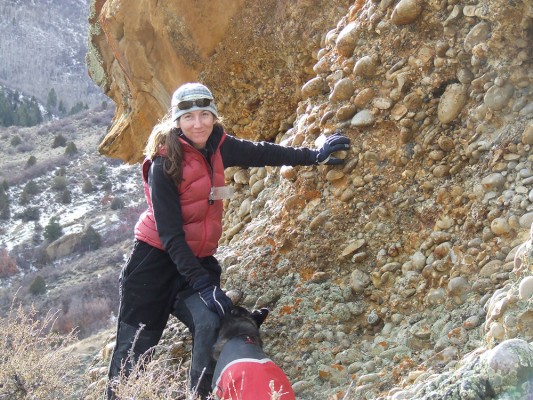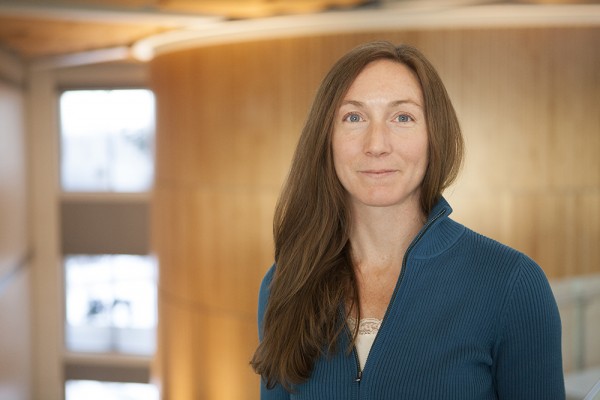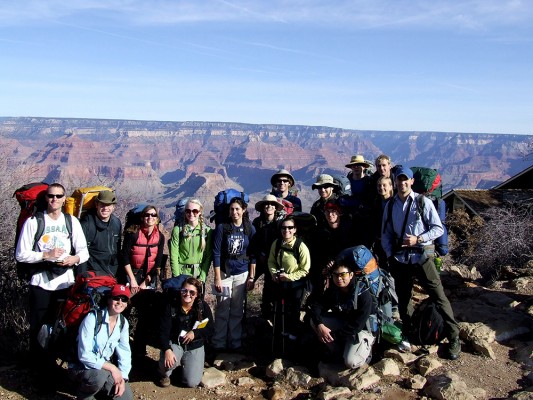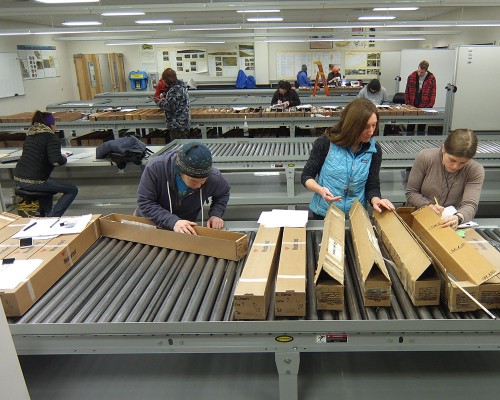Geology professor: Making a career of revealing trapped treasures
by Tracy Kalytiak |

Dr. Jennifer Aschoff spends time in the field in northern Utah, where she has studied geology for much of her career. (Photo courtesy of Jennifer Aschoff)
Dr. Jennifer Aschoff grew up on the coast of Maine and moved to Montana with nothing more than a duffel bag at age 18. She was the first person in her family to attend a university. Now, Aschoff works as a geology professor at UAA. She talks about her passion for geology and what she sees ahead for geoscience at UAA.
When did you first become aware of and interested in geology?
In high school I knew right away I wanted to be a geologist because it was the one science discipline that integrated all the science fields I loved-chemistry, biology and physics. I took a course in earth sciences in high school in my senior year and was hooked for life.

Dr. Jennifer Aschoff works with industry partners like ConocoPhillips and Schlumberger to help UAA's effort to provide industry-relevant education to geology students. (Photo by Philip Hall / University of Alaska Anchorage)
What was it about geology that fascinated you to the point of wanting to make it your life's work?
As a geology student I was intrigued by stratigraphy. These layered sedimentary rocks are essentially like stacks of photographs of ancient landscapes.
Once I learned to interpret the ancient landscapes from the stratigraphy, I knew geology would become my life's work.
What did you do in academia before moving to Alaska?
I earned a Bachelor of Science degree at Montana State University-Bozeman, then went on to a Master of Science degree at New Mexico State University where I completed two internships-one with the U.S. Geological Survey and one with Phillips Petroleum. When I finished my M.S. in geology, I worked for two years at Montana State as a research associate then attended the University of Texas at Austin-one of the best geology programs in the country-where I earned my Ph.D.
Where did you first begin teaching?
My first "real" job was as an assistant professor at Colorado School of Mines, a very research-oriented university. After a couple of years at CSM, I decided to gain more industry experience and spend more time with a sick family member, so I took a job with BP-Houston in 'Global Unconventional Access.' I greatly enjoyed the work I was doing with BP, but felt a need to give back to the community and wanted a much more teaching-focused position where I could balance research with teaching.
When and how did you first become drawn to the study of sedimentary basins?
I worked as a research assistant at MSU, cutting rocks for the geology department there. The professor I worked for convinced me to complete a senior thesis on some Paleocene conglomerates in Idaho.
Once I started working on the sedimentary rocks in my research I knew I would continue to study the development, fill and natural resources of sedimentary basins.
If it weren't for my undergraduate research experience, I may never have found this niche. As a result, I now have a passion for undergraduate research and involve as many undergraduate students as I can in research, and serve on the Undergraduate Research Task Force here at UAA.

Dr. Jennifer Aschoff takes a group of students to the Grand Canyon for the first time. (Photo courtesy of Jennifer Aschoff)
Why is research into this topic so critical?
Research in sedimentary basins is important for, one, understanding Earth's history, and, two, natural resource development.
From an academic perspective, sedimentary basins contain the record of ancient mountain ranges that have long since been denuded.
By studying the fill of basins we can reconstruct the location, geometry and tectonic origin of ancient mountain ranges, and their relation to landscape evolution over millions of years.
From an applied perspective, the vast majority of our water and energy resources are contained within sediments and sedimentary rocks within various sedimentary basins.
Understanding the origin and fill of sedimentary basins provides insight into the resource potential and distribution of such things as water, oil and gas.
Where has your research taken you?
Geographically, my research has taken me all around the world. I've mostly worked in the Rocky Mountains, but have also worked in Argentina, Spain, Norway, Canada and Mexico.
What have been the most intriguing research avenues you've explored?
I'm mostly interested in the role the mantle plays in the development of sedimentary basins. Many geologists assume crustal tectonics, such as mountain building, is the only control on the development of sedimentary basins, but new research suggests we should be thinking deeper and investigating the role of the mantle.
When did you first become interested in traveling to and living in Alaska?
Alaska has everything I love in the world-the ocean, the mountains and wonderful people. When I first visited Alaska in 2013, I knew this would be a place I could spend a lifetime exploring.
What research projects have you delved into here?
Many of my research projects are still centered in the Lower 48, but I have one graduate student who is working on a petroleum geology project on the North Slope.
Veronica Jones is a new interdisciplinary M.S. student in geology. She will be working on subsurface data-rock core, well logs and seismic data-to better understand the petroleum production trends in deepwater sandstone reservoirs in fields such as Tarn, Meltwater and Nanuq.
I think this project could have a great deal of impact on exploration and production in Alaska, because it'll help us better predict the more prolific oil-gas reservoirs. This, of course, means we can more efficiently extract these resources in Alaska.
What challenges have you faced (in the course of your teaching) that will now be removed by UAA's new ConocoPhillips Geoscience Computing Laboratory?
The greatest challenge thus far has been the lack of powerful, in-class computing facilities. Geologists must learn to think in four dimensions, that is 3D plus the element of long time-scales.
Many of the newest modeling software programs allow us to show 3D visualizations of the Earth's crust, and this helps students learn to visualize geology.
I'm especially excited to integrate map-making into my courses in stratigraphy for their field exercises. Geologists are very visual scientists, so we must make a wide range of complex 3D diagrams, maps and other figures to convey our ideas.
Students learn to make professional-quality figures and posters in my Professional Practices course.
The new lab will allow me to work with them to build the best products, using the Adobe suite, and could help integrate a wide range of other software applications, such as hydrogeologic modeling, into courses like hydrogeology.

Dr. Jennifer Aschoff, a UAA geology professor, and students prepare for a core rock workshop. (Photo courtesy of Jennifer Aschoff)
What are some examples of software programs you feel are vital to students seeking jobs?
ArcGIS, for example. There is an array of ArcGIS courses offered at UAA, but our geology courses should really be integrating GIS into some of our courses to reinforce skills they learn in other classes.
What ideas have you incorporated into the trips and projects you make available for your students?
The student project I'm most proud of is the annual rock core workshop I started in December 2014 (my first year at UAA) and continued this past December.
Students in my stratigraphy and depositional systems courses spend three weeks describing rock core at the Alaska Geologic Materials Center.
They make detailed interpretations of the ancient environments exhibited in the core taken from 3,000-8,000 feet below the ground.
Some of the rocks they describe are more than 350 million years old, and the rock description really emphasizes just how much the landscape has changed over that time.
I've heard this workshop provides a way for students to educate people in the community.
For their final project, students create a professional poster and present their descriptions, interpretations and final conclusions to the general public and local geology professionals at the workshop held at the GMC.
We had about 50 participants this year, ranging from local professors in geology to a home-school group interested in learning how oil-gas wells are drilled.
The students gain valuable experience in communicating complex geologic concepts to a diverse community, and the community can be part of the learning process. Everyone seems to enjoy the event!
What is planned for the master's degree program in geoscience?
The geology department is very keen to develop an M.S. in geological sciences at some point in the future to cater to the local industry, which needs qualified employees.
We have an advisory group consisting of local professionals from oil-gas, mining, USGS, consulting and environmental industries, which is helping us craft the perfect program to help them get the skilled employees they need.
UAA is very receptive to industry opinion, and the faculty here try to adjust the courses to supply students with real-world skills our advisory group and local industry need.
Currently, the geology department has about seven graduate students through the interdisciplinary M.S. program as we discuss an M.S. in geology.
Through this program, three of these students are working with me on a wide range of stratigraphy and petroleum-related projects. The program is quite rigorous and emphasizes experience through research, but supplements their research with relevant courses from geology, engineering, computer sciences and business colleges at UAA.
Why is such a program needed here in Alaska?
Our local industry partners, especially those on our advisory group, suggest there is a need for qualified applicants with real-world skills in addition to the classical geology training students get from a university.
So, the first reason we need an M.S. here is to fill the need from local industry as evidenced by our advisory group.
Secondly, the entry-level degree for the highest-paying jobs in geology is an M.S. We are doing a disservice to our students and the Anchorage community if we do not offer the degree that will help them best support their families and get jobs here in Alaska, and beyond.
In which ways have you worked with industry to provide the most relevant education possible to geology students?
I interface regularly with local industry, such as ConocoPhillips, BP, Schlumberger, IHS, ASRC, USGS and more. It takes quite a lot of time to engage with these individuals, but it's well worth the effort.
Students have had so many more opportunities through our industry partnerships-from the judges at our core workshop to guest speakers and all the hard work our advisory group does.
UAA Geology would not have made it so far without their support.
Notably, I worked very hard to ascertain a wide range of subsurface interpretation software from companies such as Schlumberger and IHS.
Schlumberger gave a $33-million suite of geology software to UAA last year.
The donation from Schlumberger was the largest in-kind donation in the University of Alaska System. That Petrel software is currently used in my research group, and will be used in courses as soon as the new computer laboratory is completed.
How else do you help connect students to the industry?
I reach out to industry professionals throughout the community to act as judges for best poster at my annual core workshop; the judges have worked North Slope in stratigraphy for decades and are a vital source of experience and information for students.
I'm just thrilled we have so much support.
Past support has come from Alaska Oil and Gas Conservation Commission, USGS, DOG, ConocoPhillips, BP and PangoMedia, and I hope their support continues.
Compiled by Tracy Kalytiak, UAA Office of University Advancement
 "Geology professor: Making a career of revealing trapped treasures" is licensed under a Creative Commons Attribution-NonCommercial 4.0 International License.
"Geology professor: Making a career of revealing trapped treasures" is licensed under a Creative Commons Attribution-NonCommercial 4.0 International License.









